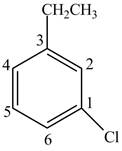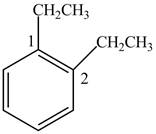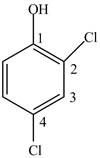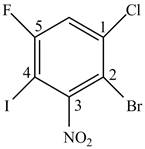
(a)
Interpretation:
The name of the benzene derivative compound is to be stated.
Concept introduction:
IUPAC stands for International Union of Pure and Applied Chemistry. The IUPAC gave certain rules which are used worldwide to name the organic compounds. Due to IUPAC naming, each compound has a unique name which is different from their common name.
In aryl compounds, the substituents are indicated by the numbers and the aromatic ring is named as benzene.
Answer to Problem 16.1P
The IUPAC name of the aromatic compound is
Explanation of Solution
(1) The six-membered aromatic ring is named as benzene.
(2) If a
(3) The substituents on the benzene ring are indicated by the numbers and are named in alphabetical order.
(4) The lowest locant rule is used. The substituent which comes first in the alphabetical order is numbered one and then the numbering is done in the direction such that the other substituent gets the maximum lower numerical value.
(5) If a functional group is attached on the benzene ring, then that carbon is numbered one.
In Figure 1, the benzene ring contains chloro and the ethyl group. The numbering starts from the carbon atom containing chloro group since it comes first in the alphabetical series and the numbering is done according to lowest locant rule.

Figure 1
The rule of naming an aromatic compound according to IUPAC is
Therefore, the IUPAC name of the aromatic compound is
The IUPAC name of the aromatic compound is
(b)
Interpretation:
The name of the benzene derivative compound is to be stated.
Concept introduction:
IUPAC stands for International Union of Pure and Applied Chemistry. The IUPAC gave certain rules which are used worldwide to name the organic compounds. Due to IUPAC naming, each compound has a unique name which is different from their common name.
In aryl compounds, the substituents are indicated by the numbers and the aromatic ring is named as benzene.
Answer to Problem 16.1P
The IUPAC name of the aromatic compound is
Explanation of Solution
Aromatic compounds are those compounds which contains at least one aromatic ring. The naming of aromatic compounds uses the same rules as aliphatic compounds.
(1) The six-membered aromatic ring is named as benzene.
(2) If a functional group is present on the benzene ring, then the benzene is named as phenyl.
(3) The substituents on the benzene ring are indicated by the numbers and are named in alphabetical order.
(4) The lowest locant rule is used. The substituent which comes first in the alphabetical order is numbered one and then the numbering is done in the direction such that the other substituent gets the maximum lower numerical value.
(5) If a functional group is attached on the benzene ring, then that carbon is numbered one.
In Figure 2, the benzene ring contains two ethyl groups. So, numbering can be done from any carbon containing ethyl group using lowest locant rule.

Figure 2
The rule of naming an aromatic compound according to IUPAC is
Therefore, the IUPAC name of the aromatic compound is
The IUPAC name of the aromatic compound is
(c)
Interpretation:
The name of the benzene derivative compound is to be stated.
Concept introduction:
IUPAC stands for International Union of Pure and Applied Chemistry. The IUPAC gave certain rules which are used worldwide to name the organic compounds. Due to IUPAC naming, each compound has a unique name which is different from their common name.
In aryl compounds, the substituents are indicated by the numbers and the aromatic ring is named as benzene.
Answer to Problem 16.1P
The IUPAC name of the aromatic compound is
Explanation of Solution
Aromatic compounds are those compounds which contains at least one aromatic ring. The naming of aromatic compounds uses the same rules as aliphatic compounds.
(1) The six-membered aromatic ring is named as benzene.
(2) If a functional group is present on the benzene ring, then the benzene is named as phenyl.
(3) The substituents on the benzene ring are indicated by the numbers and are named in alphabetical order.
(4) The lowest locant rule is used. The substituent which comes first in the alphabetical order is numbered one and then the numbering is done in the direction such that the other substituent gets the maximum lower numerical value.
(5) If a functional group is attached on the benzene ring, then that carbon is numbered one.
In Figure 3, the benzene ring contains nitro and the vinyl group. The numbering starts from the carbon atom containing nitrro group since it comes first in the alphabetical series and the numbering is done according to lowest locant rule.

Figure 3
The rule of naming an aromatic compound according to IUPAC is
Therefore, the IUPAC name of the aromatic compound is
The IUPAC name of the aromatic compound is
(d)
Interpretation:
The name of the benzene derivative compound is to be stated.
Concept introduction:
IUPAC stands for International Union of Pure and Applied Chemistry. The IUPAC gave certain rules which are used worldwide to name the organic compounds. Due to IUPAC naming, each compound has a unique name which is different from their common name.
In aryl compounds, the substituents are indicated by the numbers and the aromatic ring is named as benzene.
Answer to Problem 16.1P
The IUPAC name of the aromatic compound is
Explanation of Solution
Aromatic compounds are those compounds which contains at least one aromatic ring. The naming of aromatic compounds uses the same rules as aliphatic compounds.
(1) The six-membered aromatic ring is named as benzene.
(2) If a functional group is present on the benzene ring, then the benzene is named as phenyl.
(3) The substituents on the benzene ring are indicated by the numbers and are named in alphabetical order.
(4) The lowest locant rule is used. The substituent which comes first in the alphabetical order is numbered one and then the numbering is done in the direction such that the other substituent gets the maximum lower numerical value.
(5) If a functional group is attached on the benzene ring, then that carbon is numbered one.
In Figure 4, the benzene ring contains two chloro groups and one functional group, hydroxyl group. The name of the benzene ring will become phenyl. The numbering starts from the carbon atom containing hydroxyl group since it is a functional group and then the substituents are numbered using lowest locant rule.

Figure 4
The rule of naming an aromatic compound according to IUPAC is
Therefore, the IUPAC name of the aromatic compound is
The IUPAC name of the aromatic compound is
(e)
Interpretation:
The name of the benzene derivative compound is to be stated.
Concept introduction:
IUPAC stands for International Union of Pure and Applied Chemistry. The IUPAC gave certain rules which are used worldwide to name the organic compounds. Due to IUPAC naming, each compound has a unique name which is different from their common name.
In aryl compounds, the substituents are indicated by the numbers and the aromatic ring is named as benzene.
Answer to Problem 16.1P
The IUPAC name of the aromatic compound is
Explanation of Solution
Aromatic compounds are those compounds which contains at least one aromatic ring. The naming of aromatic compounds uses the same rules as aliphatic compounds.
(1) The six-membered aromatic ring is named as benzene.
(2) If a functional group is present on the benzene ring, then the benzene is named as phenyl.
(3) The substituents on the benzene ring are indicated by the numbers and are named in alphabetical order.
(4) The lowest locant rule is used. The substituent which comes first in the alphabetical order is numbered one and then the numbering is done in the direction such that the other substituent gets the maximum lower numerical value.
(5) If a functional group is attached on the benzene ring, then that carbon is numbered one.
In Figure 5, the benzene ring contains chloro, bromo, fluoro, iodo and nitro groups. The numbering is done using the lowest locant rule.

Figure 5
The rule of naming an aromatic compound according to IUPAC is
The IUPAC name of the aromatic compound is
(f)
Interpretation:
The name of the benzene derivative compound is to be stated.
Concept introduction:
IUPAC stands for International Union of Pure and Applied Chemistry. The IUPAC gave certain rules which are used worldwide to name the organic compounds. Due to IUPAC naming, each compound has a unique name which is different from their common name.
In aryl compounds, the substituents are indicated by the numbers and the aromatic ring is named as benzene.
Answer to Problem 16.1P
The IUPAC name of the aromatic compound is
Explanation of Solution
Aromatic compounds are those compounds which contains at least one aromatic ring. The naming of aromatic compounds uses the same rules as aliphatic compounds.
(1) The six-membered aromatic ring is named as benzene.
(2) If a functional group is present on the benzene ring, then the benzene is named as phenyl.
(3) The substituents on the benzene ring are indicated by the numbers and are named in alphabetical order.
(4) The lowest locant rule is used. The substituent which comes first in the alphabetical order is numbered one and then the numbering is done in the direction such that the other substituent gets the maximum lower numerical value.
(5) If a functional group is attached on the benzene ring, then that carbon is numbered one.
(6) If benzene ring is a substitutent, it is named as phenyl.
In Figure 6, the benzene rings are subtituents on the methyl group.

Figure 6
The rule of naming an aromatic compound according to IUPAC is
Therefore, the IUPAC name of the aromatic compound is
The IUPAC name of the aromatic compound is
Want to see more full solutions like this?
Chapter 16 Solutions
Organic Chemistry, Ebook And Single-course Homework Access
- Correct each molecule in the drawing area below so that it has the skeletal ("line") structure it would have if it were dissolved in a 0.1 M aqueous solution of HCI. If there are no changes to be made, check the No changes box under the drawing area. No changes. HO Explanation Check NH, 2 W O :□ G ©2025 M unter Accessibilityarrow_forwardAn expression for the root mean square velocity, vrms, of a gas was derived. Using Maxwell’s velocity distribution, one can also calculate the mean velocity and the most probable velocity (mp) of a collection of molecules. The equations used for these two quantities are vmean=(8RT/πM)1/2 and vmp=(2RT/M)1/2 These values have a fixed relationship to each other.(a) Arrange these three quantities in order of increasing magnitude.(b) Show that the relative magnitudes are independent of the molar mass of the gas.(c) Use the smallest velocity as a reference for establishing the order of magnitude and determine the relationship between the larger and smaller values.arrow_forwardThe reaction of solid dimethylhydrazine, (CH3)2N2H2, and liquefied dinitrogen tetroxide, N2O4, has been investigated for use as rocket fuel. The reaction produces the gases carbon dioxide (CO2), nitrogen (N2), and water vapor (H2O), which are ejected in the exhaust gases. In a controlled experiment, solid dimethylhydrazine was reacted with excess dinitrogen tetroxide, and the gases were collected in a closed balloon until a pressure of 2.50 atm and a temperature of 400.0 K were reached.(a) What are the partial pressures of CO2, N2, and H2O?(b) When the CO2 is removed by chemical reaction, what are the partial pressures of the remaining gases?arrow_forward
- One liter of chlorine gas at 1 atm and 298 K reacts completely with 1.00 L of nitrogen gas and 2.00 L of oxygen gas at the same temperature and pressure. A single gaseous product is formed, which fills a 2.00 L flask at 1.00 atm and 298 K. Use this information to determine the following characteristics of the product:(a) its empirical formula;(b) its molecular formula;(c) the most favorable Lewis formula based on formal charge arguments (the central atom is N);(d) the shape of the molecule.arrow_forwardHow does the square root mean square velocity of gas molecules vary with temperature? Illustrate this relationship by plotting the square root mean square velocity of N2 molecules as a function of temperature from T=100 K to T=300 K.arrow_forwardDraw product B, indicating what type of reaction occurs. F3C CF3 NH2 Me O .N. + B OMearrow_forward
- Benzimidazole E. State its formula. sState the differences in the formula with other benzimidazoles.arrow_forwardDraw product A, indicating what type of reaction occurs. F3C CN CF3 K2CO3, DMSO, H₂O2 Aarrow_forward19) Which metal is most commonly used in galvanization to protect steel structures from oxidation? Lead a. b. Tin C. Nickel d. Zinc 20) The following molecule is an example of a: R₁ R2- -N-R3 a. Secondary amine b. Secondary amide c. Tertiary amine d. Tertiary amidearrow_forward
 ChemistryChemistryISBN:9781305957404Author:Steven S. Zumdahl, Susan A. Zumdahl, Donald J. DeCostePublisher:Cengage Learning
ChemistryChemistryISBN:9781305957404Author:Steven S. Zumdahl, Susan A. Zumdahl, Donald J. DeCostePublisher:Cengage Learning ChemistryChemistryISBN:9781259911156Author:Raymond Chang Dr., Jason Overby ProfessorPublisher:McGraw-Hill Education
ChemistryChemistryISBN:9781259911156Author:Raymond Chang Dr., Jason Overby ProfessorPublisher:McGraw-Hill Education Principles of Instrumental AnalysisChemistryISBN:9781305577213Author:Douglas A. Skoog, F. James Holler, Stanley R. CrouchPublisher:Cengage Learning
Principles of Instrumental AnalysisChemistryISBN:9781305577213Author:Douglas A. Skoog, F. James Holler, Stanley R. CrouchPublisher:Cengage Learning Organic ChemistryChemistryISBN:9780078021558Author:Janice Gorzynski Smith Dr.Publisher:McGraw-Hill Education
Organic ChemistryChemistryISBN:9780078021558Author:Janice Gorzynski Smith Dr.Publisher:McGraw-Hill Education Chemistry: Principles and ReactionsChemistryISBN:9781305079373Author:William L. Masterton, Cecile N. HurleyPublisher:Cengage Learning
Chemistry: Principles and ReactionsChemistryISBN:9781305079373Author:William L. Masterton, Cecile N. HurleyPublisher:Cengage Learning Elementary Principles of Chemical Processes, Bind...ChemistryISBN:9781118431221Author:Richard M. Felder, Ronald W. Rousseau, Lisa G. BullardPublisher:WILEY
Elementary Principles of Chemical Processes, Bind...ChemistryISBN:9781118431221Author:Richard M. Felder, Ronald W. Rousseau, Lisa G. BullardPublisher:WILEY





